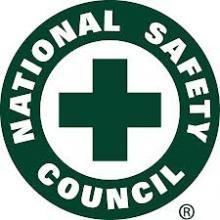
A group of industrial leaders from the Midwest met in 1912 because of their concern about safety in the U.S. workplace. They came to the conclusion that there should be an organization to promote safety. A year later in Chicago on October 13, the National Council for Industrial Safety was founded at the Second Safety Congress in New York City with 200 attendees. In order to broaden the scope and to include non-industrial safety issues, the name of the organization was changed to the National Safety Council (NSC) the following year.
The National Safety Council is a nonprofit membership organization located in Itasca, Illinois. Throughout the years they have worked to keep safety in the workplace, homes, and on the roads through education, leadership, advocacy, and research. The U.S. Chamber of Commerce and the NSC initiated the Uniform Vehicle Code, which in 1924 was a model for traffic laws in every state.
In 1953, President Dwight D. Eisenhower recognized the NSC’s leadership in coordinating safety efforts by approving an Act of Congress that granted a Congressional Charter to the NSC. The first Defensive Driving Course was started by the NSC in 1964 and has more than 2,500 authorized Defensive Driving Course Training Centers and more than 8,800 certified Defensive Driving Course Instructors throughout the world. They have worked along with the National Transportation Safety Board to reduce the injuries and fatalities at railroad crossings. They were one of the first organizations to increase national seat belt usage and support child restraint laws. Then in 1996 in partnership with 150 corporations and other organizations, NSC led the Air Bag & Seat Belt Safety Campaign, thereby reducing child deaths by air bags and increasing U.S. seat belt usage.1
Injuries and deaths to children on the playground prompted the National Safety Council to issue a Checklist for Playground Safety. This includes accommodations for disabled children set forth by the Americans with Disabilities Act (ADA) and that all playground equipment should be in good condition.
The Top Ten Checklist includes:
- Surfaces around playground equipment should be filled with at least 12 inches of loose fill.
- Stationary equipment should have a 6 foot use zone in every direction.
- Any openings with the possibility of trapping a child should be less than 3.5 inches apart or more than 9 inches.
- Guardrails should surround all elevated platforms and should be at least 29 inches high for preschool children and 38 inches high for school age children.
- Anything that could possibly trip a child like exposed concrete footings, rocks or tree roots.
- Sharp and dangerous hardware and protruding bolts.
- All children should be on age appropriate playground equipment.
- Regular maintenance of the playground.
- Children should not wear hoods or drawstrings that could possibly be caught on the equipment.
- All children should be supervised on the playground.2
The National Safety Council also publishes a paper on Supervising Children on the Playground, which gives techniques and training tips to those that will be supervising the playground.3
- 1. “National Safety Council History.” National Safety Council. < http://www.nsc.org/about_us/Pages/NSCHistory.aspx > 16 Aug. 2010.
- 2. National Safety Council 04/09
- 3. “Under A Watchful Eye: Supervising Children on the Playground.” NSC Education. < http://ww.nsc.org/mem/edu/playgd.htm > 18 Apr. 2010.

